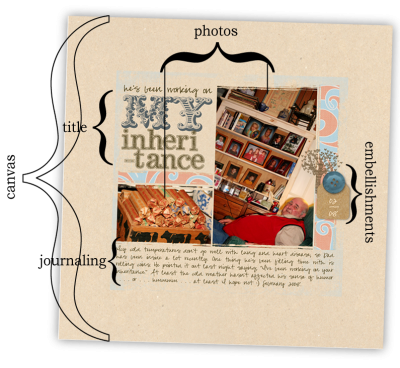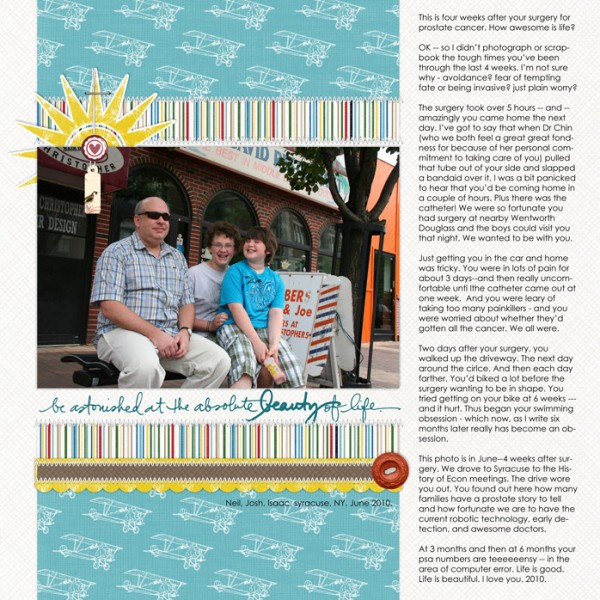by Debbie Hodge
Photos are easier to come by today than ever before.
You take them with your phone as well as your camera. Your partner, parent, child, friends are taking photos on their phones and cameras and sending them to you via email or facebook or their preferred photo sharing website. You can even find photos you didn’t get a chance to take (i.e., of a place you visited) online from generous Flickr photographers or stock photo sites.
Photos are streaming into your life now from multiple sources. If these photos are not organized and explained, they quickly become a mass that’s not meaningful and that’s even too overwhelming to begin looking through.
How can you catalog and record the memories of this stream of photos efficiently and meaningfully?
Scrapbook them.
Scrapbook? Really?
Some of you are all over the idea of a scrapbook. It appeals to your story-telling, photo-cataloging, crafty selves.
Others of you will have no desire to make a weighty book of photos and memorabilia that will require more time to create and space to store than you’re willing to afford.
Let’s redefine scrapbook
A scrapbook is made up of scrapbook “pages.”

A scrapbook “page” combines some or all of the 5 basic scrapbook page elements.
- photos
- journaling
- title
- embellishments
- the canvas upon which these sit.
A scrapbook “page” can be
- on and of actual paper
- a digital rendering of the traditional scrapbook page
- a blog post
- a slide in a slideshow
- anything and any size and any medium you want it to be.

Here a scrapbook page is shown as: 1) a blog post, 2) an arrangement of photos, journaling, title, 3) a 12″x12″ scrapbook page, 4) a slide in a slideshow.
How to start making your kind of “scrapbook page”
Include some or all of the scrapbook page elements.
1) Photos.
Select one or more photos of a moment or event that you like looking at and thinking about right now.
Sure, you might like to remember everything (at least all of it that’s good) but if you want to keep living a life that’s worth taking a photos of there isn’t the time to record all of it. So pick the photos you want to record right now.
2) Journaling
Write the information that you’ll need in order to recall the who and what—and, most importantly, the details that make the particulars of the photo worth remembering.
Ask yourself: Why do I like looking at this photo right now? It might be a sentence. It might be a longer piece of writing. The key is that YOU are telling the story now so that when someone (including you) comes across this photo in later years they comprehend it in a meaningful way. They see and read the story as you told it. They know why it was important enough to select for special treatment (special treatment=your version of a scrapbook page) by reading this journaling.
3) Title
A title can be a great cue to deeper meaning, a reminder of something fun, or simply a label of place or event or people that you then may or may not have to include in your journaling. You can include one or not.
4) Canvas
Combine photos, journaling, and title onto a “canvas” that works for you. When choosing your canvas, understand that it will need to be stored in a way that you can access tomorrow and in 10 years. For paper canvases, that could mean an album or archival box. For digital canvases, that could mean a folder on your computer’s hard drive, an “album” at a photo storage and sharing site, printed pages or even a printed and bound photobook.
Your canvas could be:
– a physical piece of paper
– a digital canvas
– a blog post
– a slide in a slideshow
– you tell me!
NOTE: YOU can define size if you’re not using traditional paper albums or an online service’s photobooks.
Your canvas background could be a solid background or you could use patterned papers (paper or digital) or a combination of papers and other elements (it’s up to you: ribbon, memorabilia, mats . . .).
The benefit of choosing a background that’s not simply solid white or black, is that it offers you the opportunity to set the tone for your page and perhaps even include a relevant motif.
5) Embellishments
Embellishments are the little decorations that add charm (and that should support your page subject and or tone). Maybe they’re not for you — but there are useful functions embellishments can play on a scrapbook page.
Start scrapbooking because it makes your photos accessible records of your life.
So that’s it. You should start scrapbooking because otherwise your photos will become part of an undefinable mass that doesn’t tell your stories. Photos can be preserved to evoke feelings, trigger associations, and tell those who see them in the future what YOUR story was. If you don’t scrapbook they will be part of a large collection that doesn’t really convey why the individual photo matters.

There will even be times when you don’t have a photo but there’s an important story or milestone in your family’s life that should be preserved–that will matter to those involved tomorrow and in 25 years. Looking through my scrapbook pages from 2010 and reviewing where my family had been that year, I realized I never told the story of my husband’s surgery for prostate cancer. Talk about an important story! And, talk about this being the kind of thing you’d like to remember not only in details but in feelings. That’s what scrapbooking does for you — it tells your stories the way you’d tell them — not the way others looking through photos guess at them.
Think of scrapbooking as:
- Selecting photos that compel you.
- Writing about them.
- Perhaps titling them.
- Putting them onto some kind of “canvas.”
- Storing that canvas in a way that you can access in years to come.
Let’s start a pictorial-memoir, photographic-story-telling stampede. If you’re already a scrapbooker, show this to your friends who are not so they’ll see just why you scrapbook (and maybe get going themselves).[current]


